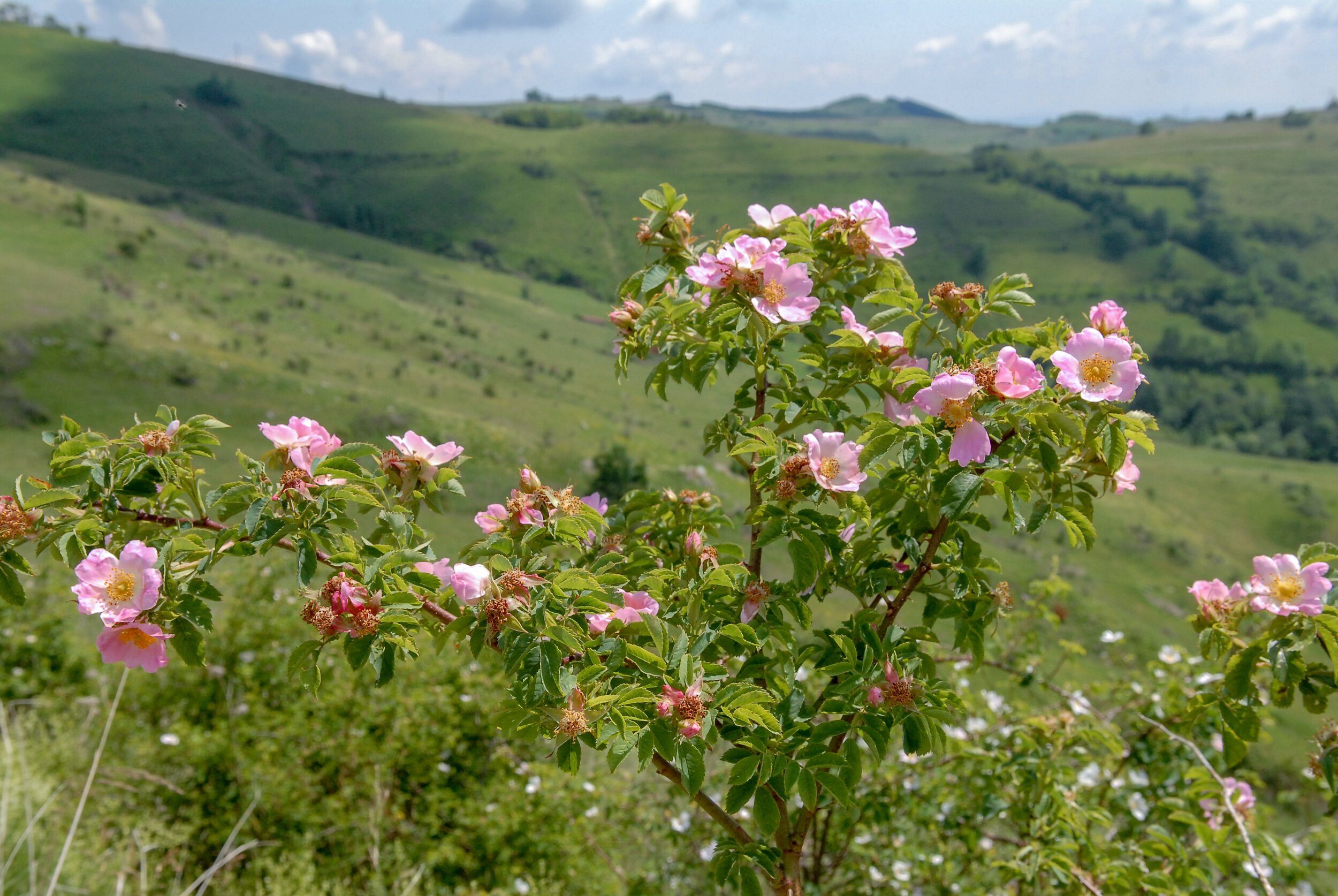Rosehip seed oil
Chase Kempinski, PhD (chase@tritera.co)
Wild roses in the field.
Rosehips are the pseudo-fruits of plants in the genus Rosa, which like the name suggests includes the common ornamental roses. If you have only ever been around horticultural roses you may have never seen them, as the petals in garden roses are sometimes packed too tight to allow pollinators in or old flowers are removed before the rosehip can develop. The rosehips and seeds generally used in commerce are derived from Rosa canina (dog rose) and Rosa rubiginosa (sweet briar/rosa mosqueta), which are both usually referred to as “wild roses” (1, 2). The flowers of these plants do not resemble the highly bred ornamental roses and are often simple looking.
Rosehips before harvest.
Rosehips fruits are dried and eaten or made into powders for tonics in cultures throughout the world. Both the fruit and oil from the seeds is abundant with antioxidant activity. The fleshy part of the fruit contains some of the highest amounts of vitamin C found in plants examined so far (3). There are nutritional supplement brands which sell powdered rosehips for their antioxidant and anti-inflammatory properties. Some of these are marketed to help with joint health. A review examining clinical studies done with a proprietary rosehip supplement indicated moderate evidence that it helped with symptoms of osteoarthritis (4). The academic literature is sparse in discussing the history of rosehip seed oil in cosmetics applications. However, there have been several studies indicating the positive attributes for skincare.
The seeds inside rosehips.
The seeds that form within the rosehips contain about 6-15% oil (1, 5). The seed oil is rich in polyphenols, unsaturated fatty acids, and vitamin E—all powerful antioxidants (2). A Spanish self-reported study examining topical application of Rosehip seed oil on post-surgery scars found reduced redness and atrophy (indented scar) formation when applied twice daily after 12 weeks (6). The authors suggest that the lipid profile might allow for better permeability of the recovering cells to important healing signals. Another group in China demonstrated that topical rosehip seed oil accelerated wound-healing by inhibiting inflammation and promoting collagen biosynthesis and the formation of new blood vessels (7). The high amounts of a-linoleic acid present in the oil could also be helpful in protecting against UV damage and skin hyperpigmentation (8).
Tritera uses cold-pressed, virgin rosehip seed oil. This preserves the most desirable chemical constituents and keeps the oil most effective. All these properties make it an excellent addition to your skincare routine!
References
1. M. Nogala-Kalucka, M. Rudzinska, R. Zadernowski, A. Siger, I. Krzyzostaniak, Phytochemical content and antioxidant properties of seeds of unconventional oil plants. JAOCS, J. Am. Oil Chem. Soc. 87, 1481–1487 (2010).
2. H. Ilyasoǧlu, Characterization of rosehip (Rosa canina L.) seed and seed oil. Int. J. Food Prop. 17, 1591–1598 (2014).
3. I. Mármol, C. Sánchez-De-Diego, N. Jiménez-Moreno, C. Ancín-Azpilicueta, M. Rodríguez-Yoldi, Therapeutic applications of rose hips from different Rosa species. Int. J. Mol. Sci. 18, 1–37 (2017).
4. C. Chrubasik, B. D. Roufogalis, U. Müller-Ladner, S. Chrubasik, A systematic review on the Rosa canina effect and efficacy profiles. Phyther. Res. 22, 725–733 (2008).
5. M. Özcan, Nutrient Composition of Rose ( Rosa canina L. ) Seed and Oils. J. Med. Food 5, 137–140 (2002).
6. P. Valerón-Almazán, A. J. Gómez-Duaso, N. Santana-Molina, M. A. García-Bello, G. Carretero, Evolution of Post-Surgical Scars Treated with Pure Rosehip Seed Oil. J. Cosmet. Dermatological Sci. Appl. 05, 161–167 (2015).
7. Z. Lei, et al., Rosehip Oil Promotes Excisional Wound Healing by Accelerating the Phenotypic Transition of Macrophages. Planta Med. 85, 563–569 (2019).
8. E. M. Moore, C. Wagner, S. Komarnytsky, The Enigma of Bioactivity and Toxicity of Botanical Oils for Skin Care. Front. Pharmacol. 11, 1–17 (2020).




